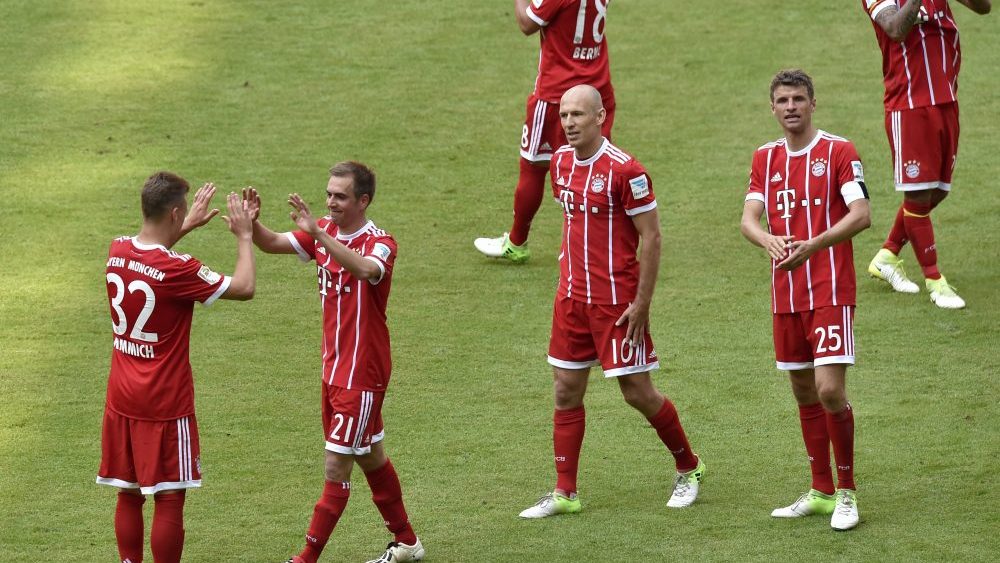Stats & Links: Quality time with Jupp, Pep, and Carlo
Ten years ago, club boss Karl-Heinz Rummenigge, after a disappointing 2-2 defeat by Bolton Wanderers in the UEFA Cup, spoke frustrated into the TV camera: “Football is not mathematics that can be calculated”. A statement that was addressed directly against his manager Ottmar Hitzfeld, a trained mathematics teacher, and his rotation.
During his tenure, Hitzfeld was notorious for his rotation. He knew how to manage like few others at that time on the narrow line between balancing the playing minutes and the egos of the stars. Hitzfeld was thus a kind of pioneer in this field, especially in the Bundesliga.
In the meantime, the rotation has become a necessary standard, which is the only way for a team to cope with the heavy workload in today’s schedule with a much more intensive playing style. In addition, the rotation is also an excellent way to introduce young players to the team.
Nevertheless, it was not only the FOCUS (German newspaper) that headlined last year: “The rotation is no longer a trump card for the champion”. Therefore, in today’s article a deeper look at the rotation under ex-coach Ancelotti will be taken, especially in comparison with Pep Guardiola and Jupp Heynckes.
In order to be able to evaluate this, we use a suggestion of Vignesh Velu (@noobiefootball).
The simplest way to evaluate the distribution is to use the playing minutes. However, they have the disadvantage that they do not take into account the quality of the opponents. Thus minutes against the Ingolstadts and Augsburg’s of this world are just as valuable as a highlight game against Dortmund or Leipzig.
Therefore, the minutes are judged according to the strength of the opponent. This is done by using the end-of-season table to sort the opponents. The best placed opponent, Leipzig last year as runner-up, will be ranked with 0.95, the other teams with each 0.05 points less up to the last place in the standings. This factor is then multiplied by the number of minutes in the respective game to obtain the quality minutes.
Finally, a quality percentage is calculated. For this purpose, the scored quality minutes are divided by the total number of minutes played and multiplied by 100.
The last three seasons under Ancelotti and Guardiola were examined as well as the triple season under Heynckes – in each case for the Bundesliga.
Of course, injuries play a major role here and can reduce the significance of the statistics. Furthermore, this method is only another useful addition to the current view of the rotation, but does not claim to be able to fully analyze it.
Who did Carlo trust?
First of all, the past season is examined under Carlo Ancelotti. The Italian was repeatedly criticized in the season because he supposedly did not trust young players enough – especially in the important games. In general, less rotation was performed than among its predecessors.
Just after his dismissal, two more storylines came to the public: The perceived lack of esteem for international players such as Jerome Boateng and Thomas Müller, as well as the Spanish-speaking section of the team, which Ancelotti presumably preferred internally. With the evaluation of the data, these two points can also be evaluated neutrally, at least from the outside.
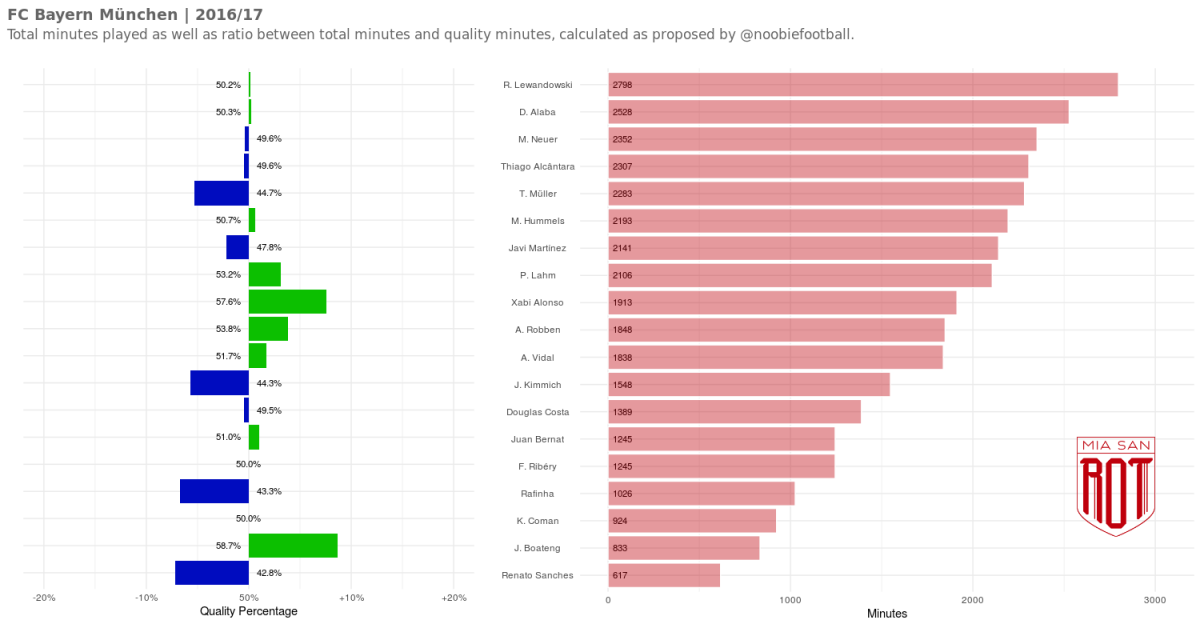
(Analytics: Lukas)
Players are sorted in descending order according to the total number of minutes they have played. Players with less than 500 minutes of playing time are excluded. Looking at the four players with the most minutes – Lewandowski, Alaba, Neuer and Thiago – the quality percentage doesn’t show any peculiarity. All four of them are close to 50% and have therefore been used in a balanced manner.
Thomas Müller is the first player to stand out. Although the German international played the fifth most minutes of the season, he was not allowed to play against the big opponents in the Bundesliga. In the first half of the season, Müller was left out in the first game against Leipzig by Ancelotti. However, it also plays a role that he had to pause against Dortmund and Hoffenheim injured in the second half of the season.
However, Müller was only substituted for just under twenty minutes in the first leg against Hoffenheim and in the second leg against Leipzig. Especially in connection with the short appearances in the return leg against Madrid and the cup semi-final against Dortmund, Müller’s agitation can be understood.
For the Spanish “Connection”, on the other hand, there are no supporting statistics. Javi Martinez is even slightly less than 50% and clearly behind Boateng, although his scores are distorted by his long injury. Xabi Alonso, on the other hand, is the best placed with 57.6% next to Boateng. The great Maestro was allowed to rest more often against the smaller opponents.
Finally, we would like to take a look at the young players. Last season, Kimmich, Coman and Sanches were three players in the squad, younger than 23 and playing for more than 500 minutes.
Sanches and Kimmich are characterized by the low quality percentage. While Kimmich’s total playing time of 1,548 minutes is a step up from last year, this shows that he collected only a few minutes against major opponents. Here, Ancelotti did not seem to think he could play the role of the organizing hand in the midfield.
This picture is also confirmed by looking at the other competitions. In the six games against Atletico, Arsenal and Real Kimmich only played a total of 80 minutes. The young player from Rottweiler was also only allowed to compete in the cup for 31 minutes from the round of sixteen – not at all against Dortmund in the semi-finals.
Renato Sanches shows a similar picture. The Portuguese only played 142 minutes in two games against the top 7 of the table. In the Champions League, too, he was usually only on the bench. One of the reasons why the youngster is looking for his luck this year with a loan in Swansea.
Pep rotates with the youth
As in the season under Ancelotti, Lewandowski, Alaba and Müller are among the five players with the most minutes in Pep’s third season 2015/16. All four of them have about 50% quality percentage, suggesting that they have been used evenly against all opponents.
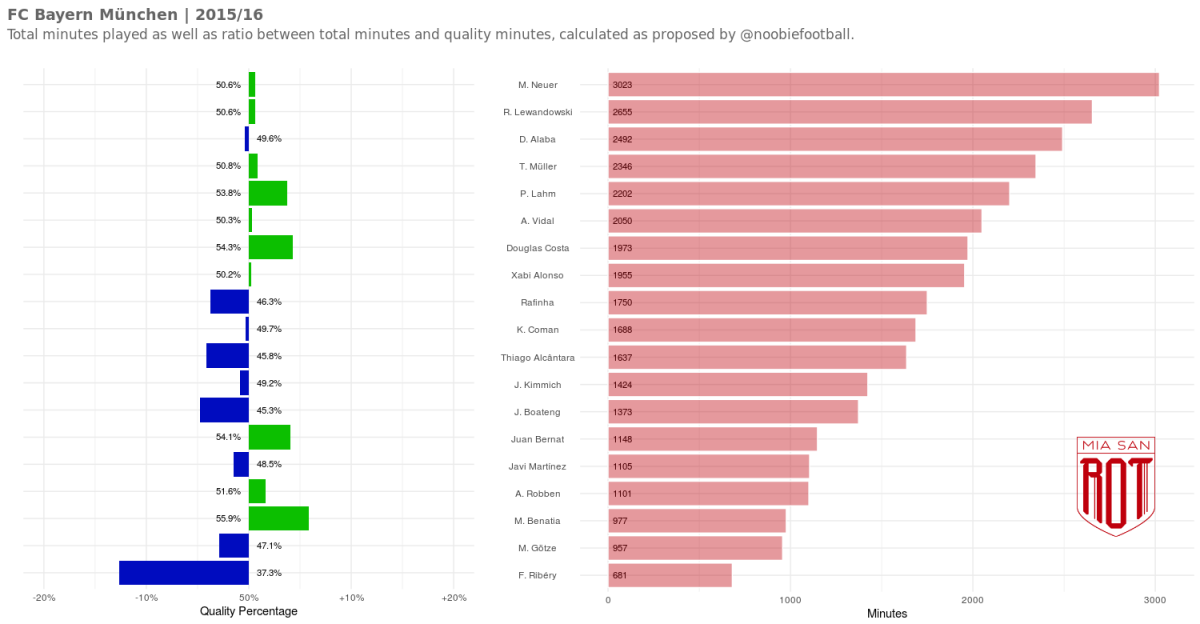
(Analytics: Lukas)
Guardiola trusted Phillip Lahm against the strong teams, while he also protected him against weaker opponents. This is evident both in his quality percentage and in Rafinha’s, who mostly replaced him.
Costa and surprisingly Bernat and Benatia have the highest quality percentage in the team, while Thiago, Boateng and Ribery fall off. The latter, however, was mainly due to his long-term injury.
The young Coman and Kimmich were also used in more important games. Both were also allowed to play on a big stage in the Champions League. There, both the Frenchman with his last-minute assist and goal against Juve and the German with his strong performance in the unfamiliar central defender position played their part in the progress. Here Pep was strengthened in his decision.
Many minutes against weaker opponents
The rotation for the second Guardiola season 2014/15 shows a completely different picture than the just observed season.
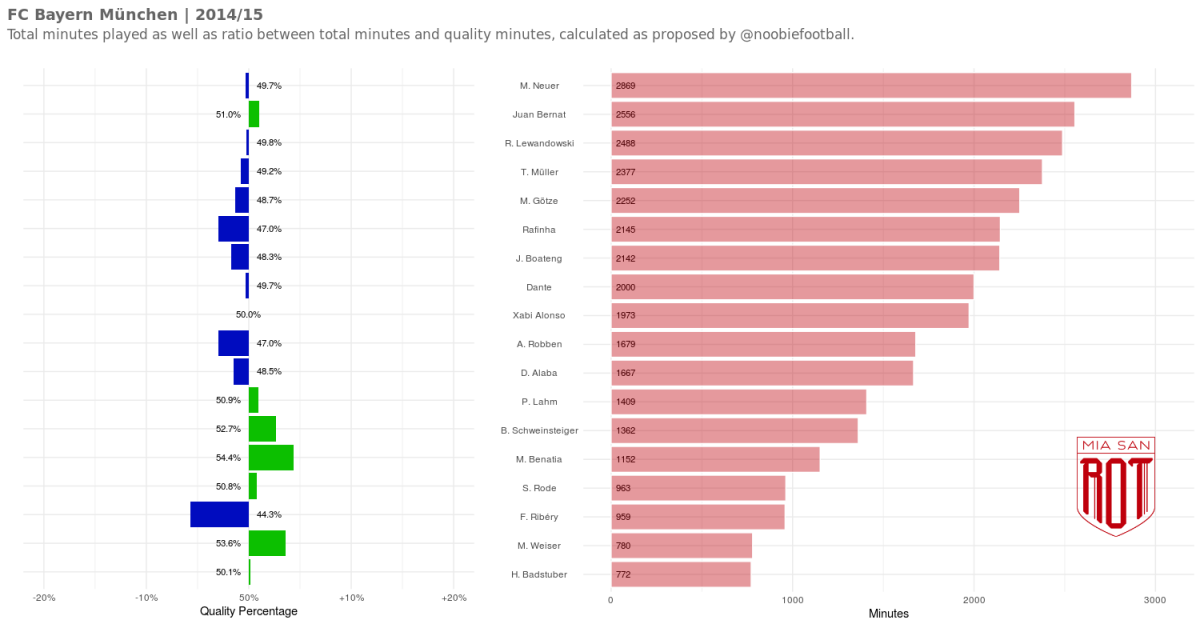
(Analytics: Lukas)
This season, Bernat, Götze and Rafinha are three of the top 6 players of the season, unexpectedly. Rafinha benefits from Lahm’s long absence with an ankle fracture.
Interestingly, out of the eleven players with the most playing minutes, nine have a quality percentage less than 50%, they were used mainly against weaker opponents.
Bastian Schweinsteiger leads the list with Benatia. Although Schweinsteiger was often rested by Guardiola, most of the time he was allowed to participate in the highlights in the league. Even a young Mitchell Weiser was quite trusted by Guardiola, as his quality percentage shows.
A total of eight players were deployed for more than 2,000 minutes. This is the same as last season under Ancelotti.
Jupp rotated more extreme in the triple season
In the triple season under the new and old coach Jupp Heynckes he showed a completely different face than in the previous season. In the “runner-up year” in 2012, Jupp let seven players complete more than 75% of the playing minutes. In the triple season, it was only four of them – Neuer, Dante, Lahm and Schweinsteiger.
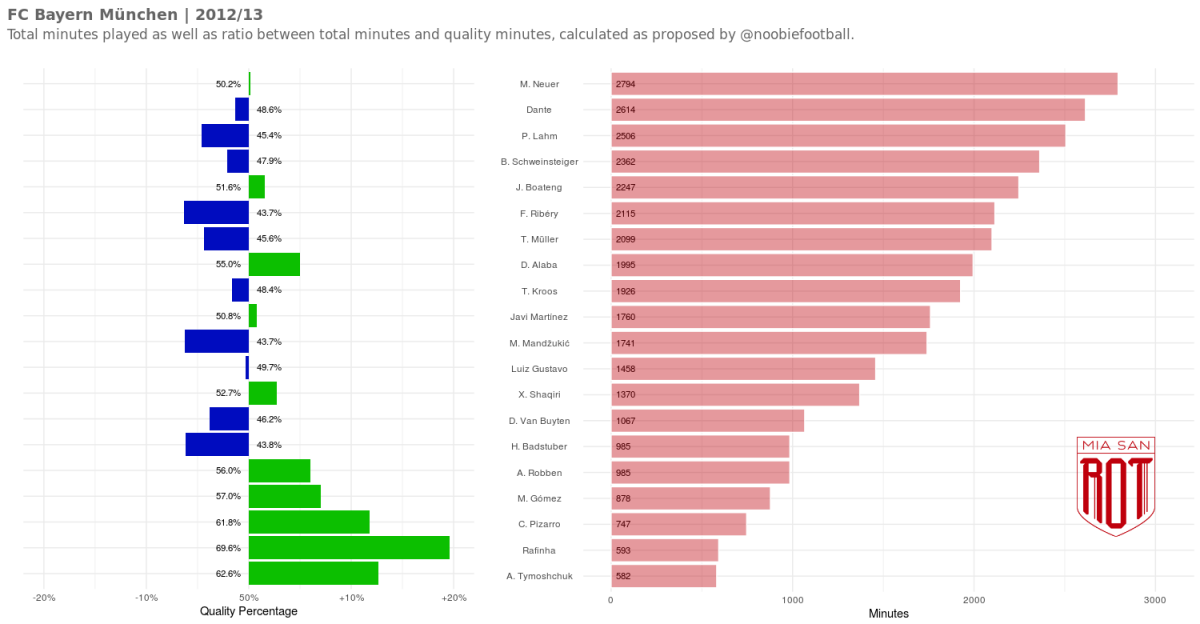
(Analytics: Lukas)
As the chart shows, Heynckes interestingly enough, let players compete in the supposedly important Bundesliags games who had just a few minutes. Rafinha, Tymoshchuk and Pizarro are all three beyond 60% with their quality percentage. The highest value over the four seasons considered.
Similarly, Ribery, Müller, Badstuber and Mandzukic were often not involved in the matches against the larger opponents. Heynckes took advantage of the last few matchdays, when the league was already decided, to give his important players a breather before the big and decisive matches in the cup competitions.
Is there a perfect rotation?
Is there a general development or a “sweet spot” for distributing the minutes in the Bavarian squad? In order to answer these questions and to recognize the respective handwritings of the coaches, the following chart shows the seasons since 2005.

(Analytics: Lukas)
With the exception of the Heynckes 2011/12 season, the rotation behaviour of the Bavarian squad has stabilised at a relatively constant level since 2010, with a maximum of 4 players in the Bundesliga playing more than 75% of the minutes. There are two possible explanations for this. On the one hand, the core of the squad has remained together and has therefore become older over the years, demanding more rest and suffering from more injuries. On the other hand, during this time, constant investments were made in the depth of the squad to be able to better control the work load and compensate for injuries.
In the last season under Ancelotti, there were only 3 players in the end, who played more than 75% of the minutes in the Bundesliga. Rotation took place, but above all the integration of young players and the necessary transition from key positions to younger players was not forced.
Links of the week
Bayern back on track, Leipzig fancy a European run, Dortmund’s costly draw | Raphael Honigstein | ESPN
Celtic thrashed by rampant Bayern Munich in Champions League mis-match | Ewan Murray | Guardian
Tactical Analysis – Heynckes’ 4-2-3-1 against Freiburg | Ryan Tank | Bundesliga Fanatic
FC Bayern launches first Augmented Reality Fan Experience | FC Bayern
Bayern Munich Vs Freiburg | Tobias Hahn | ESDF Analysis
Javi Martinez key to Jupp Heynckes’ plans to fix Bayern Munich | Raphael Honigstein | ESPN FC
The motivated player | Omar Chaudhuri | 21st Club
Arjen Robben: how Holland will miss the wonderful master of cutting inside | Priya Ramesh | Guradian
Recent Miasanrot articles
Youth teams in autumn 2017 – part 3 | Martin | Michael
3 Things We Noticed: FC Bayern – Celtic Glasgow 3-0 (2-0) | Christopher | Dennis
Youth teams in autumn 2017 – part 2 | Martin | Luca
Youth teams in autumn 2017 – part 1 | Martin | Luca
3 Things We Noticed: FC Bayern – SC Freiburg 5-0 (2-0) | Tobi
Preview: FC Bayern – SC Freiburg | Justin | Maurice
Recent stats, maps and graphics
You are currently viewing a placeholder content from X. To access the actual content, click the button below. Please note that doing so will share data with third-party providers.



